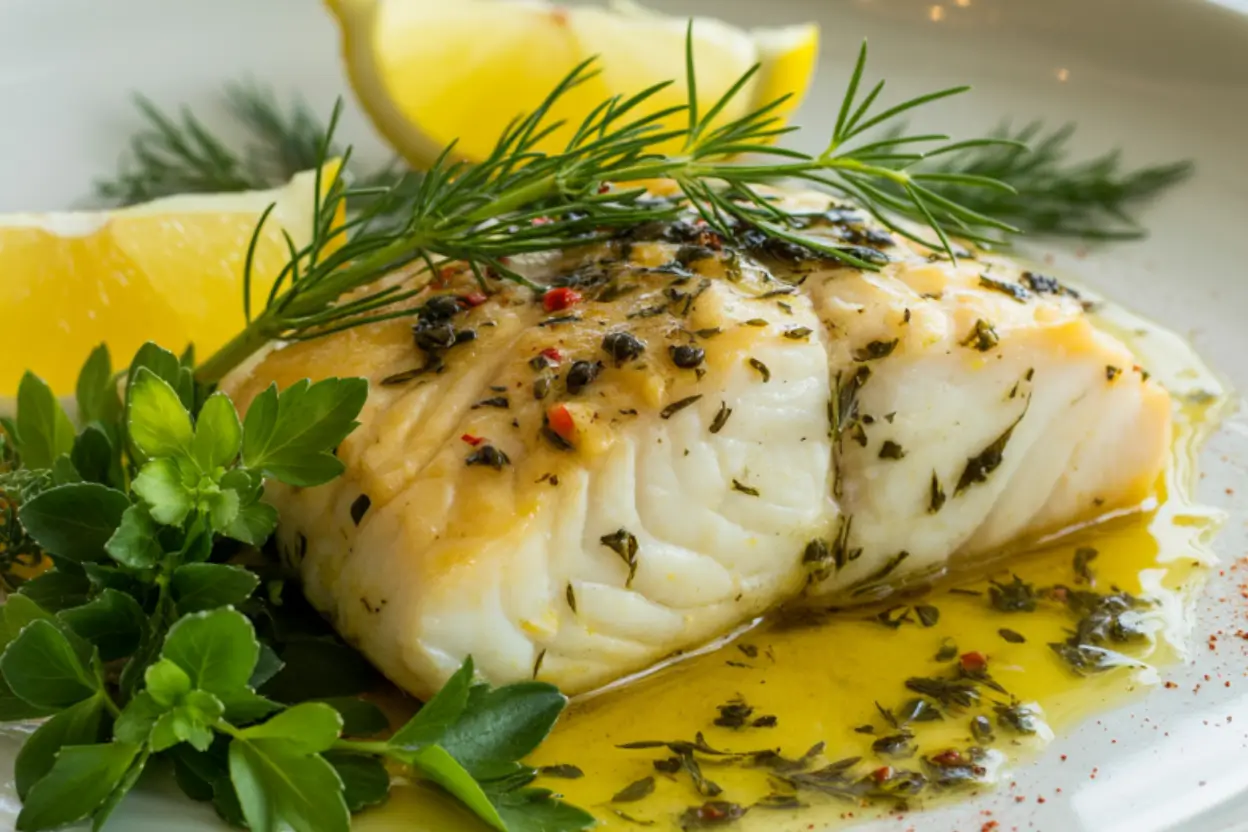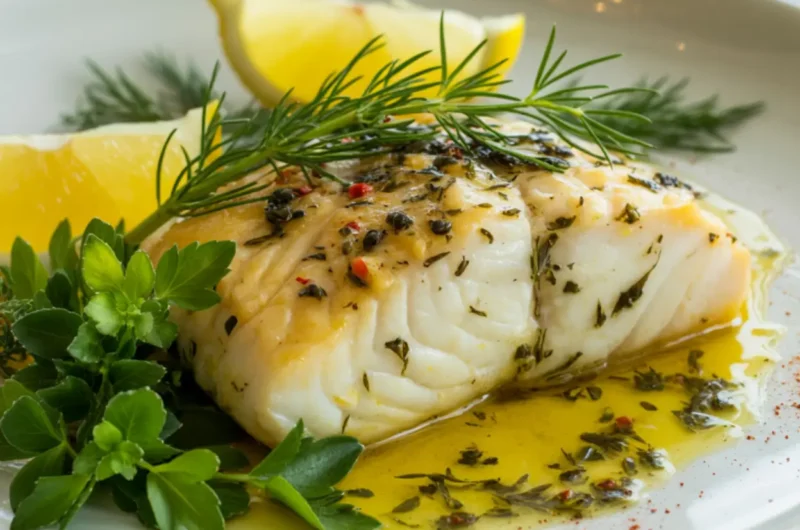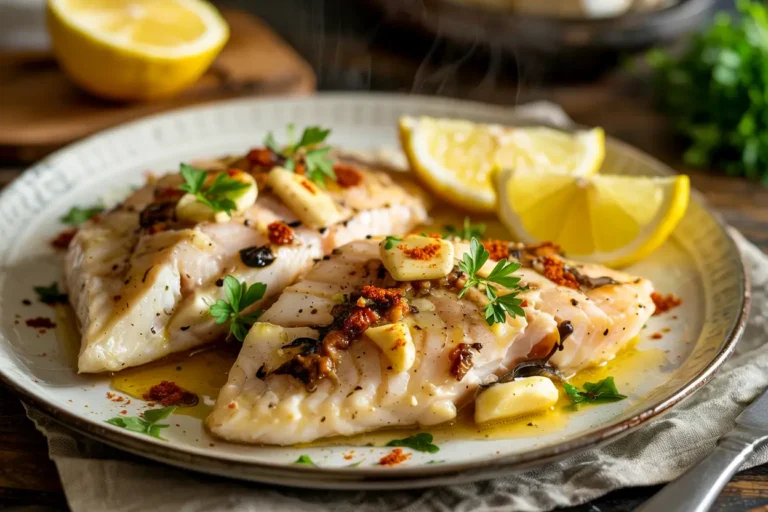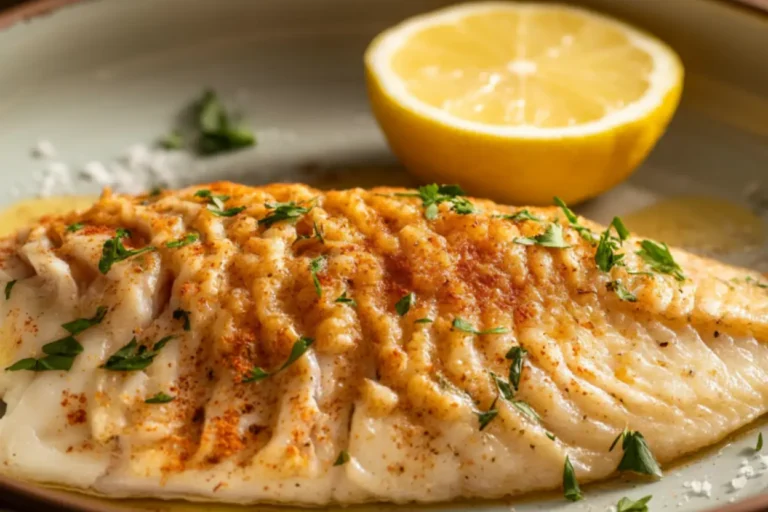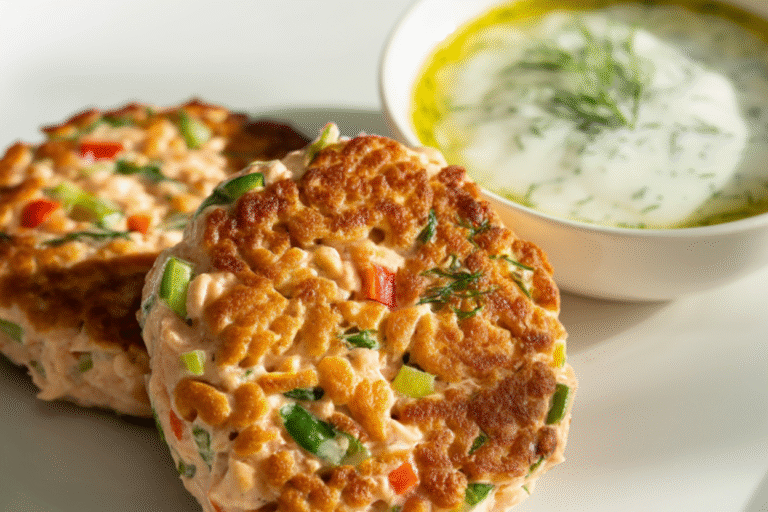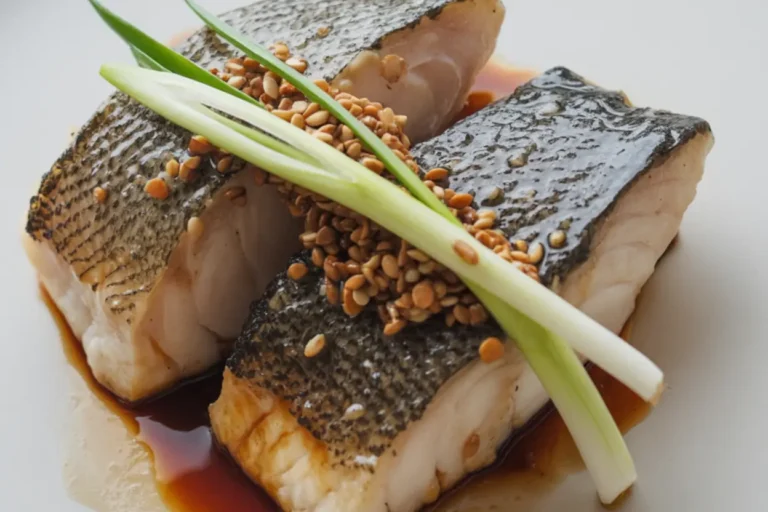Baked Halibut Recipe: How to Keep It Juicy Every Time
Table of Contents
Halibut is often referred to as the “steak of seafood” for good reason; its firm, meaty texture and mild, sweet flavor make it a favorite even among people who don’t typically enjoy fish. However, this prized catch comes with a challenge: its lean nature means it can quickly go from perfectly cooked to disappointingly dry. After years of experimenting with different techniques, I’ve perfected a baked halibut recipe that delivers moist, flaky results every single time. This method celebrates halibut’s natural flavor while ensuring it remains juicy and tender, the holy grail of fish preparation.
Thank you for reading this post, don't forget to subscribe!How to Make Baked Halibut:
Quick Overview
This baked halibut recipe stands out for its foolproof approach to cooking a notoriously easy-to-dry-out fish. The secret lies in a gentle cooking method that uses butter, herbs, and a moderate oven temperature to create a protective environment for the delicate fish. The result is halibut that’s incredibly moist on the inside with a subtle, golden crust on the outside.
What makes this recipe particularly special is the lemon-herb butter that both flavors the fish and helps seal in moisture during baking. The combination of fresh herbs, bright citrus, and rich butter complements the mild sweetness of halibut without overwhelming it. You’ll also appreciate how clean-tasting and light the finished dish is—satisfying without being heavy.
From start to finish, this recipe takes just 30 minutes, with only 10 minutes of active preparation time. The simplicity and speed make it perfect for weeknight dinners, yet the results are impressive enough for special occasions or entertaining guests.
The Ingredients I Use to Bring My Baked Halibut to Life
For the fish:
- 4 halibut fillets (about 6 oz each), skin removed
- 2 tablespoons olive oil
- Salt and freshly ground black pepper
For the herb butter:
- 4 tablespoons unsalted butter, softened
- 2 cloves garlic, minced
- 1 tablespoon fresh lemon juice
- 1 teaspoon lemon zest
- 2 tablespoons fresh parsley, finely chopped
- 1 tablespoon chopped fresh thyme (or 1 teaspoon dried thyme)
- 1 tablespoon fresh dill, chopped (optional)
- ¼ teaspoon red pepper flakes (optional)
- ½ teaspoon salt
- ¼ teaspoon freshly ground black pepper
For serving:
- Lemon wedges
- Additional fresh herbs for garnish
Step-by-Step Instructions
1. Prepare the Fish
Start by taking your halibut fillets out of the refrigerator about 15-20 minutes before cooking. Allowing the fish to come closer to room temperature helps it cook more evenly. While you’re waiting, preheat your oven to 375°F (190°C).
Pat the halibut fillets dry with paper towels. This step is crucial—excess moisture on the surface of the fish will create steam in the oven and prevent proper browning. Once dry, place the fillets on a plate and drizzle them with olive oil, then gently rub the oil over both sides of each piece. Generously season both sides with salt and freshly cracked black pepper.
2. Make the Herb Butter
In a small bowl, combine the softened butter, minced garlic, lemon juice, lemon zest, chopped parsley, thyme leaves, dill (if using), red pepper flakes (if using), salt, and pepper. Using a fork, mash and stir the ingredients together until they’re well incorporated. This compound butter will be the secret weapon that keeps your halibut moist and adds tremendous flavor.
If your butter isn’t quite soft enough, don’t microwave it—that can cause it to melt completely, which isn’t what we want. Instead, just work it with the fork a bit longer until it becomes pliable and easily mixable with the herbs and seasonings.
3. Prepare the Baking Dish
Select a baking dish that’s large enough to hold all four fillets without crowding them. A little space between pieces allows for more even cooking. Lightly coat the bottom of the dish with olive oil or cooking spray to prevent sticking.
4. Add the Fish and Butter
Place the seasoned halibut fillets in the baking dish. Using a spoon or your fingers, spread the herb butter evenly over the top of each fillet, creating a layer that covers the entire surface. Don’t worry if some butter slides off—it will create a flavorful sauce in the bottom of the dish that you can spoon over the fish when serving.
5. Bake to Perfection
Transfer the baking dish to the preheated oven and bake for 12–15 minutes. Cooking time may vary based on the thickness of your fillets—about 12–13 minutes is ideal for a 1-inch thick piece. Thicker fillets might require the full 15 minutes or a bit longer.
The key to juicy halibut is to not overcook it. The fish is done when it’s opaque throughout and flakes easily when gently pressed with a fork. If you have a kitchen thermometer, the internal temperature should reach 130-135°F (54-57°C).
6. Rest and Serve
Once done, remove the baking dish from the oven and let the halibut rest for 3-5 minutes. This resting period allows the juices to redistribute throughout the fish, ensuring maximum moisture retention.
Once rested, carefully place each fillet onto a serving plate. Drizzle with the melted butter and pan juices from the baking dish. Finish with a garnish of fresh herb sprigs and serve alongside lemon wedges for squeezing over the top.
What to Serve Baked Halibut With
This delicate, herb-infused halibut pairs beautifully with a variety of side dishes. Here are some of my favorite accompaniments:
Vegetable Sides:
- Roasted asparagus with lemon zest and Parmesan
- Sautéed spinach with garlic and a touch of cream
- Roasted cherry tomatoes with herbs and garlic
- Steamed green beans with toasted almonds
- Zucchini ribbons quickly sautéed with olive oil and herbs
Starchy Sides:
- Creamy mashed potatoes or cauliflower puree
- Wild rice pilaf with mushrooms
- Simple risotto with lemon and peas
- Crusty bread for soaking up the buttery sauce
- Fingerling potatoes roasted with herbs
Fresh Options:
- Light cucumber and dill salad
- Citrus salad with fennel and avocado
- Simple mixed greens with a light vinaigrette
Wine Pairings:
- Unoaked or lightly oaked Chardonnay
- Sauvignon Blanc
- Pinot Grigio
- Dry Riesling
- For something different, try a light-bodied Pinot Noir

Top Tips for Perfecting Baked Halibut
After preparing halibut countless times, I’ve gathered some invaluable insights to help you achieve the best results:
Selecting the Best Halibut:
- Look for firm, translucent flesh with no brown spots or discoloration.
- Fresh halibut should smell clean and oceanic, never fishy.
- If using frozen halibut, thaw it slowly in the refrigerator overnight rather than using quick-thaw methods.
- Center-cut pieces tend to cook more evenly than tail sections.
Temperature Matters:
- Bringing the fish close to room temperature before cooking is critical for even baking.
- Using an oven thermometer ensures your oven is actually at the temperature it claims to be.
- Invest in an instant-read digital thermometer to check doneness without cutting into the fish.
Cooking Technique Adjustments:
- If your fillets vary in thickness, position the thicker pieces toward the back of the oven, which is typically hotter.
- For extra-thick fillets (over 1.5 inches), start them on the stovetop. Sear in an oven-safe skillet for 2 minutes, then finish in the oven for 10-12 minutes.
- If you prefer a more golden top, switch the oven to broil for the final minute of cooking—but watch carefully to prevent burning.
Moisture Preservation Strategies:
- For even juicier results, try baking the halibut in parchment paper packets (en papillote) with the butter and herbs.
- Adding a splash of white wine or fish stock to the baking dish creates additional steam and flavor.
- Never use very high heat with halibut; gentle cooking is key.
Ingredient Substitutions:
- No fresh herbs on hand? You can substitute with dried herbs—just use one-third the amount (1 tablespoon fresh equals 1 teaspoon dried).
- Butter can be replaced with olive oil for a dairy-free version, though the result will be slightly less rich.
- Other firm white fish like cod, sea bass, or haddock can be substituted for halibut using the same method, adjusting cooking time based on thickness.
Common Mistakes to Avoid:
- Overcooking is a frequent mistake. Keep in mind that the fish will continue to cook from residual heat even after it’s out of the oven.
- Not patting the fish dry before seasoning can prevent proper browning and dilute flavors.
- Checking doneness too frequently by opening the oven door, which releases heat and extends cooking time.
Storing and Reheating Tips
Halibut is best enjoyed fresh from the oven, but proper storage and reheating can help maintain its quality if you have leftovers:
Refrigerator Storage:
- Allow any leftover baked halibut to cool to room temperature, but don’t leave it out for more than 30 minutes.
- Keep leftovers in an airtight container in the refrigerator for up to 2 days—beyond that, the quality of the fish declines noticeably.
- Keep the butter sauce! Store it with the fish to help prevent drying during reheating.
Freezing (If Necessary):
- While I generally don’t recommend freezing cooked halibut because it can affect the texture, it is possible if needed.
- Wrap individual portions tightly in plastic wrap, then place in a freezer-safe container or heavy-duty freezer bag.
- Remove as much air as possible to prevent freezer burn.
- You can store cooked halibut in the freezer for up to 1 month. Be sure to label it with the freezing date for easy tracking.
Gentle Reheating Methods:
- For the best results, reheat slowly at a low temperature to prevent further cooking and drying out the fish.
- Preheat your oven to 275°F (135°C). Place the halibut in a baking dish, add a tablespoon of water or white wine to create steam, cover tightly with foil, and warm for about 10-15 minutes or until just heated through.
- Alternatively, for a quicker method, place the fish in a microwave-safe dish, cover with a damp paper towel, and microwave on 50% power in 30-second intervals until just warm.
Creative Leftover Ideas:
- Cold leftover halibut makes an excellent addition to a salad with mixed greens, avocado, and a light vinaigrette.
- Flake the fish and mix with a bit of mayo, lemon juice, and herbs to create a delicious sandwich filling.
- Gently fold flaked halibut into a creamy pasta dish just before serving for a luxurious seafood pasta that doesn’t require further cooking of the fish.
This baked halibut recipe proves that cooking fish at home doesn’t have to be intimidating. With the right technique and a few key ingredients, you can consistently achieve restaurant-quality results – moist, flaky halibut with beautiful flavor. The gentle baking method, combined with the protective layer of herb butter, ensures your halibut remains juicy every single time. Whether you’re cooking for a special occasion or simply wanting to incorporate more seafood into your weekly rotation, this foolproof method will become your go-to approach for perfect halibut.
click here to follow me on pinterest
Baked Halibut Recipe: How to Keep It Juicy Every Time
Cuisine: American / ContemporaryDifficulty: Easy4
servings10
minutes15
minutes360-400
kcalThis baked halibut recipe is a light yet flavorful seafood dish featuring tender fillets topped with a fragrant garlic-herb butter. A hint of lemon zest and juice brightens the dish, while optional red pepper flakes and dill add subtle complexity. It’s a quick, elegant option perfect for a weeknight dinner or special occasion.
Ingredients
4 halibut fillets (about 6 oz each), skin removed
2 tablespoons olive oil
Salt and freshly ground black pepper
4 tablespoons unsalted butter, softened
2 cloves garlic, minced
1 tablespoon fresh lemon juice
1 teaspoon lemon zest
2 tablespoons fresh parsley, finely chopped
1 tablespoon chopped fresh thyme (or 1 teaspoon dried thyme)
1 tablespoon fresh dill, chopped (optional)
¼ teaspoon red pepper flakes (optional)
½ teaspoon salt
¼ teaspoon freshly ground black pepper
Lemon wedges
Additional fresh herbs for garnish
Instructions
- Bring the Fish to Room Temp
Remove halibut fillets from the fridge 15–20 minutes before cooking. Preheat oven to 375°F (190°C). Pat fillets dry, then rub with olive oil and season both sides with salt and freshly ground black pepper. - Make the Herb Butter
In a bowl, mash together softened butter, minced garlic, lemon juice, zest, parsley, thyme, optional dill and red pepper flakes, salt, and pepper until well combined. - Prepare the Baking Dish
Lightly oil or spray a baking dish large enough to fit the fillets without crowding. This ensures even cooking and prevents sticking. - Add Fish and Butter
Place seasoned fillets in the dish. Spread herb butter evenly over each one. Some butter will melt into the dish and create a flavorful base sauce. - Bake the Halibut
Bake for 12–15 minutes, depending on thickness. The fish is done when it turns opaque and flakes easily with a fork. For precision, aim for an internal temp of 130–135°F (54–57°C). - Rest and Serve
Let the fish rest 3–5 minutes out of the oven. Plate the fillets, spoon over the melted herb butter from the pan, and garnish with fresh herbs and lemon wedges.
Notes
- Fresh herbs like parsley, thyme, and dill infuse the butter with a vibrant, aromatic flavor. Don’t skip the lemon zest, it adds a fresh citrusy punch that balances the richness of the butter. If you don’t have fresh herbs on hand, dried ones work too, just use one-third the amount. And remember: avoid overcooking the fish, as halibut can dry out quickly.

